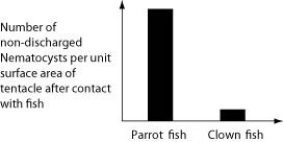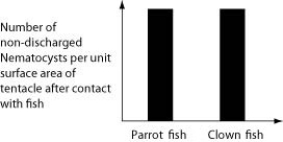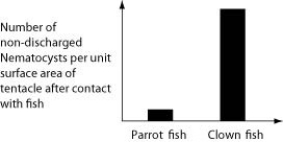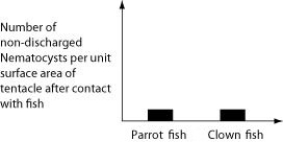Multiple Choice
Use the following information to answer the question.
An elementary school science teacher decided to liven up the classroom with a saltwater aquarium. Knowing that saltwater aquaria can be quite a hassle, the teacher proceeded stepwise. First, the teacher conditioned the water. Next, the teacher decided to stock the tank with various marine invertebrates, including a polychaete, a siliceous sponge, several bivalves, a shrimp, several sea anemones of different types, a colonial hydra, a few coral species, an ectoproct, a sea star, and several herbivorous gastropod varieties. Lastly, she added some vertebrates-a parrot fish and a clown fish. She arranged for daily feedings of copepods and feeder fish.
Normally, the clown fish readily swims among the tentacles of the sea anemones; the parrot fish avoids them. One hypothesis for the clown fish's apparent immunity is that they slowly build a tolerance to the sea anemone's toxin. A second hypothesis is that a chemical in the mucus that coats the clown fish prevents the nematocysts from being triggered. Which of the following graphs supports the second, but not the first, of these hypotheses?
A) 
B) 
C) 
D) 
Correct Answer:

Verified
Correct Answer:
Verified
Q1: Molecular studies have changed many of the
Q11: Molecular studies have changed many of the
Q27: Use the following information and figures to
Q39: The sea slug Elysia chorotica has no
Q40: Whiteflies are common pest insects found on
Q43: Which characteristic is shared by cnidarians and
Q50: Which of the following statements is correct
Q57: What would be the best anatomical feature
Q62: Use the following information to answer the
Q66: The presence of a lophophore in a